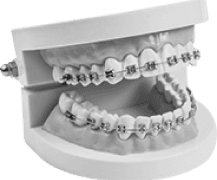MakeO blog
Dental bridges and implants are effective solutions for replacing missing teeth caused by trauma, decay, or gum disease.
As missing teeth can severely impact daily functions such as chewing and speaking, and alter your appearance and self-esteem, filling these gaps is important. This helps restore essential functions, improve your smile, and boost your confidence. Additionally, replacing missing teeth is crucial for maintaining oral health and preventing adjacent teeth from shifting into the empty space, which can lead to alignment issues and bite problems. Beyond functional and aesthetic benefits, proper tooth replacement can also support the facial structure, helping to prevent the sagging that can make you look older.
Choosing between bridges and implants for replacing missing teeth depends on factors such as the condition of your remaining teeth, bone structure, and personal preferences. This blog will explain the differences between bridges and implants, their compatibility with dental aligners, and help you make an informed decision on the best option for your needs.
When Are Bridges Needed?
Dental bridges are devices that replace lost teeth. They use false teeth in the missing teeth region that are supported by crowns on the adjacent natural teeth and are permanently fixed onto them. This mouth bridge is typically made from materials like metal or ceramics.
Bridges can help replace single or multiple missing teeth and restore the ability to chew and speak properly, thus making functionality better. They are often used when there isn’t enough bone for dental implants or when a quicker, less invasive solution is preferred. Bridges can be fitted in just a few visits and generally cost less than implants. They also do not require surgery, which is an advantage if you want to avoid a more complex procedure.
However, there are drawbacks of bridges too. These require trimming the normal adjacent teeth for support and can sometimes lead to problems with them, especially if they are not strong enough. They also need careful cleaning to prevent plaque buildup, which can cause gum issues or cavities. Plus, bridges may need to be replaced every 5-7 years.
Although these are less expensive compared to implants, when considering your options, it's important to be aware of the tooth bridge cost, as it can vary depending on the materials and the complexity of the bridge.
When Are Implants Needed?
Dental implants are a more recent innovation in tooth replacement and involve placing a titanium post into the jawbone to act as a root for an artificial tooth. After the implant integrates with the bone, a custom-made crown is attached to complete the restoration.
Implants are also typically used when replacing a single tooth or multiple teeth, especially when you prefer not to alter adjacent teeth or need a long-term solution.4,5 This is a major advantage of implants over a dental bridge as they do not require the adjacent teeth to be altered or covered with crowns. This preserves the natural structure and health of neighboring teeth. Also, in cases where the adjacent teeth are weak to support the bridge, implants can be an option provided there’s enough bone support. Moreover, implants are a good choice when a tooth is missing at the end of your jaws as there’s less support for a bridge.
For completely edentulous jaws also, implants can be placed to support the dentures, enhancing their stability and function.
Additionally, implants offer superior aesthetics because they look and function like natural teeth, and they can last a lifetime with proper care, making them more durable compared to bridges, which generally need replacement every 5-7 years. Implants also help maintain jawbone density by stimulating the bone, which can prevent bone loss often associated with missing teeth.
However, implants come with some limitations. To place an implant, the remaining jawbone should be good in quality and quantity. Plus, the implant placement procedure requires surgery, which carries risks like infection or damage to surrounding structures and can take several months to complete. They are also more expensive than bridges.
Overall, the right choice depends upon the health of your remaining teeth and bone and your personal choices. Your dentist can help determine which is the best option for you based on your specific needs.
Using Bridges/Implants with Aligners
Clear aligners are custom-made, see-through trays that gently move your teeth into the desired position. They are a popular choice because they are less noticeable and more comfortable than traditional braces.
Dental bridges and implants can work well with orthodontic aligners, yet there are some important points to consider. Aligners can only shift your natural teeth. Oral bridges and implants are fixed in place and do not move with aligner treatment. If you already have a bridge/implant, which are non-movable and securely attached, aligners will cover both the prosthesis as well as your natural teeth.
Although, if you need any changes to the teeth in your bridge, the bridge should be removed and replaced after the aligner treatment is complete.
For an implant too, it’s usually best to finish orthodontic treatment before placing it. Moreover, if you are considering implant placement and there’s insufficient space, using aligners first is a good approach to create space. Wearing a retainer after implant placement is essential though, to keep your teeth in the correct position.
So, aligners work well with both bridges and implants, helping to enhance your smile and boost your confidence.1,6 Always talk with your dentist to make the best choice for your needs and to understand the dental aligners cost and other factors.
Conclusion
Deciding between dental bridges and implants depends on your oral health condition and personal needs. Both options can replace missing teeth and improve your smile. If you’re considering aligners, they can be used with both bridges and implants, but it's important to plan the timing carefully. Always consult with your dentist to choose the best option for your situation.
FAQs
How much does a tooth bridge cost?
In India, the cost of a dental bridge typically ranges from INR 3,000 to INR 6,000 per tooth.
What is a bridge in dentistry?
A dental bridge is a fake tooth that fills in the space where a tooth is missing. It has crowns on both ends that attach to your natural teeth, with artificial teeth in the middle. This helps fill the gap and restore your smile.
Which is better, a bridge or an implant?
Dental implants are often considered better because they replace the tooth root, providing greater stability. Bridges rely on nearby teeth for support and may need those teeth to be altered.
What is bridge work dental?
Dental bridge work refers to the process of shaping the supporting teeth, taking impressions to create a custom bridge, and placing a temporary one. Once ready, the final bridge is securely attached to fill the gap.
Is a dental bridge permanent?
A dental bridge is not considered permanent. While it can last several years, typically between 5 to 15 years, factors like wear, damage, or issues with the supporting teeth may require replacement. Regular dental visits and proper oral hygiene are crucial for maintaining its condition.
How much does a 4-tooth bridge cost?
The cost of a 4-tooth dental bridge in India generally ranges from INR 12,000 to INR 24,000.
Is a dental bridge painful?
Getting a dental bridge should not be painful. Before the procedure, your dentist will administer local anaesthesia to numb your gums, ensuring you remain comfortable throughout the process. Any discomfort you may feel is typically minimal and manageable.
related categories
Related articles

Types of Braces: Removable vs Fixed Braces, Which is Right For You?

This Diwali, Smile Bright With makeO Teeth Whitening Kit

Dr. Pravin Shetty: Pioneer in Lingual Orthodontics & Innovative Smile Solutions
How do I Know I’m the Right Candidate for makeO toothsi Teeth Aligners?

